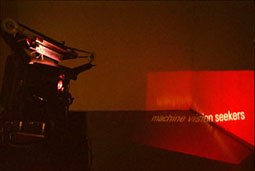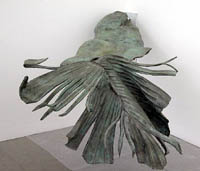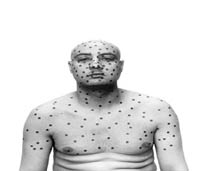
Three Film Installations.
|
Rue du Chantier 13, Brussels
Rosa Barba - Bukle & Jitter
|
Galerie Argos
|
Trhoughout April 10th, 2004
|
http://www.argosarts.org
|
|
Argos presents film installations by Rosa Barba (1972), artist fascinated by emptiness, intervals and transitional phases in which meaning dissolves for an instant. Her film installations represent cinematographic labyrinths where several layers and forms appear in an intricate game of light and shade, navigating on the tense relationship between images and non-images, duration and an instant, between the time that transpires and the single instant. Barba uses the physical aspect of film as a device to portray the subject itself and does not use it only as a medium. The network of projectors and signs is not disguised, it plays an explicit role in this deceptive world. The structure is inherent to every aspect of the installation: the projection mechanism, the celluloid, the space, the audience and the film content. The images are defined by the emptiness and “downtime”, in reference to modern filmmaking techniques of Antonioni, Tarkovsky and Straub. Pirate Rooms (2002), shows images of decrepit rooms in abandoned apartments in Budapest. The apparent scratches in the image become architectural planes that later evoke an imaginary city. The 35 mm projector, especially designed for this installation, is handled by means of a computer program, which allows the piece to run autonomously. The 16 mm installation, Split Fields (2003), consists of 3 rolls of film, projected from side to side, exploring life around the Vesuvius volcano. The celluloid goes around the room joining the space between the walls and the 3 projectors, while fictional and documentary images are intertwined. Machine Vision Seekers (2003) is a "self-referential" moving installation because it does not project a movie but the written script, while the characters are surrounded by complete darkness. The piece comes and goes from the projector to the audience, a deconstructed projection where visible and invisible elements are connected.
|
|

Peter Rogiers. Untitled, 2004, bronze sculpture, 102 x 144 x 75 cm
|
Rue Saint-Georges 6 – 8, Brussels
Peter Rogiers / Josephine Pryde
|
Galerie Xavier Hufkens
|
throughout March 20th, 2004
|
http://www.xavierhufkens.com
|
|
Peter Rogiers has worked intensely these past years with the subject of comic strips, freely exploiting the clichés that are commonly found in American comic strips, both in the content as well as in form. His intention is to eventually turn his project into an animated movie. The show of new sculptures and engravings presented by the Xavier Hufkens Gallery was developed on the basis of the context of the comic strip and the animated movie, however, in spite of the close relationship with the script, these images are in no way narrative. The anthropomorphous bronzes are reminiscent of background figures used in comic strips and palm-shaped sculptures turn into characters when they acquire precise physical forms, almost human. The engravings have an autonomous character similar to those of the sculptures. They contrast with the traditional sketches used by sculptors to faithfully capture the original work, these engravings do not describe the sculptures, they evoke an identical environment and express the same artistic concerns. Josephine Pryde, a young British artist, deals with the specific features of photography as a medium, but from a different perspective from the first modernism, in which photography was used in visual arts as a tool for documenting or as a pretext to imitate historical and figurative painting. On the other hand, Pryde uses photography as a technique for experimentation where distortions become part of a conceptual meta-level. The formal properties of the beginnings of photography are apparent in all her work with its historical contents and they are also comments about subsequent developments and new media. The evaporation of chemical substances in the image is associated to the chemical process for developing film and photographs. The properties of the medium and the image content are closely related and become inseparable.
|
|

Hicham Benohoud, B & W print, 2003, 80 x 110 cm
|
Av. De la Jonction 1, Brussels
Hicham Benohoud / Version Soft
|
Espace Photographique Contretype
|
Throughout March 7th, 2004
|
http://www.contretype.org
|
|
Hicham Benohoud was born in 1968 in Morocco, where he lives and teaches visual arts. Visual artist and photographer, his works have been regularly exhibited since 1998 and he is represented by the Vu de Paris Gallery. He has participated in several group as well as individual exhibitions in galleries and centers of Paris, Brussels, London, Marrakech, among many other cities. This exhibit, presented by the Contretype Gallery, ironically titled “Version Soft” was undoubtedly one of Benohoud·s boldest and most disconcerting works. This artist – photographer exhibited himself in a series of self-portraits hiding his identity behind various objects, treating his photographs with acids and other corrosive substances to make the faces unrecognizable. These poses created an environment of lack of communication and violence, where the subject·s looked out at nothing or were directly non-existent. It is a way of allowing the observer to get a close and raw look at the artist·s existential problems and concerns.
|
|

